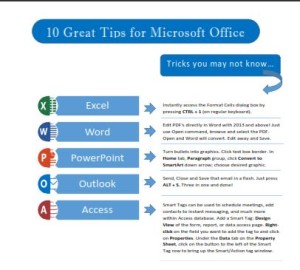Save an Office Document in PDF Format
PDF format is the perfect solution for a Word or other type of Office document when we don’t know if the intended viewer has MS Office, or we don’t want them to be able to change our content. Saving as a PDF allows opening, viewing, printing and saving but not editing our original (except for last couple of versions of Word – see note). *

You can use the File | Export | Create PDF/XPS Document command from the Ribbon or the Save As dialog box to create in PDF format. Both methods have the same result but use a little different path to get there.
If you want just a portion of your document to be saved as a PDF, select that section before you publish or save as a PDF. It is also a good idea to save as a regular Word document before creating the PDF. Just sayin’…
Export as a PDF Document
Create your PDF from the File tab:
Click File | Export and click Create the PDF/XPS icon on lower right

This displays the Publish as PDF or XPS dialog box:

- Change the file name and location for saving, if desired
- PDF is automatically chosen in the Save as type: box
- The Open file after publishing box should be automatically checked
- Click the Options… button for choosing to capture specific pages or a selection (if you highlighted previously) or for removing Document Properties which may contain sensitive information. Be aware it is checked by default.
- Click the Publish button at the bottom to display the file in your default reader software (newer computers will have this automatically installed, such as Adobe Reader)
- Close the PDF reader to return to your document
Save As Dialog Box for PDF
The F12 function key automatically brings up the Save As dialog box in all Office applications and then you can choose PDF as the format. This is the same as File | Save As but bypasses the Backstage and the extra steps:
Press the F12 function key to display the Save As dialog box

- Change the file name if desired
- Choose PDF in the drop down in the Save as type: box
- The Open file after publishing box should be automatically checked
- Click the Options… button for additional choices (same as above)
- Click Save when completed to display the file in your default reader
- Create Save As PDF Shortcut on Quick Access Toolbar
If you need to create PDF’s on a regular basis, put a shortcut on the QAT. This is in two steps as you’ll create a shortcut icon for multiple formats, and then use that one for making a shortcut icon just for creating a PDF:
- Right click on the Ribbon or Quick Access toolbar (QAT)
- Choose Customize Quick Access Toolbar
- Choose All Commands from the Choose commands from: drop down box
- Wheel down to: Save As Other Format: (the one with the arrow at the right)
- Click Add button and relocate position with arrow boxes, if desired
- Click OK

Once back in your document, you can now create a PDF shortcut with the new QAT shortcut:
- Click the drop down arrow on your new Save As icon on the QAT to see the list of available formats
- Right click over PDF or XPS and choose Add to Quick Access toolbar
- You now have icons for saving as a PDF and Save As other formats

As you can see, there are several ways to get the job done. Whether you use Publish or Save As dialog boxes is a matter of preference but I vote for the PDF shortcut on the QAT for easy peasy!
*Note: If you (or your viewer) has Word 2013 or above, PDF’s can be opened directly in Word as Word converts them to a regular document – a great feature but be aware if you have previously used PDF format specifically for document protection!
Saving in the PDF format is also a great way to preserve any special formatting or styles you created in the Word document. For instance, you might “brand” it with your logo or a text message as a watermark on all pages. If you want to explore that, take a look at this blog on Watermarks: https://gaylelarson.com/insert-watermark-in-word/
You can save other Office files in PDF format as well. The Excel process is pretty similar to above but there are differences in PowerPoint, Access and OneNote and will cover those in a future post.
Have you saved PDF’s on a regular basis and used other methods?






































 grid and choose Outlook:
grid and choose Outlook:






 Click to download great tips to speed up your Office projects.
Click to download great tips to speed up your Office projects.